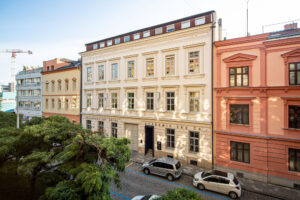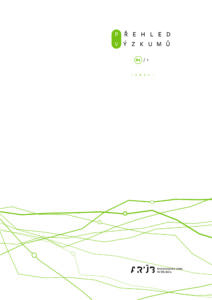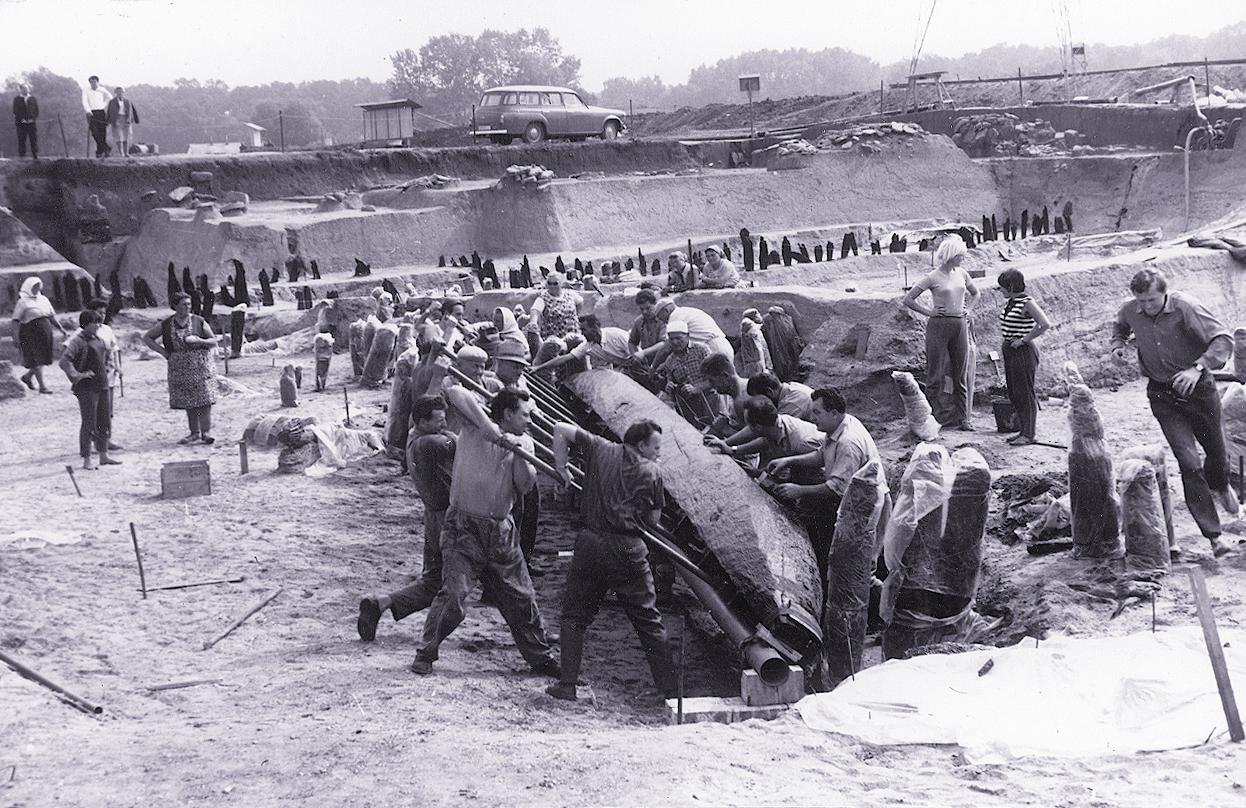Research Centre for Slavonic and Medieval Archaeology
We focus on selected parts of Central European history starting with the arrival of the Slavs in our territory in the 6th century AD and ending with the high medieval transformation of the 13–15th centuries. We acquire, document and analyse crucial archaeological records from Moravia and Czech Silesia, setting the resulting image in the context of the historical development of Europe.
We work with traditional chrono-typological analysis and by applying the principle of interdisciplinary cooperation, we utilise and coordinate a wide range of historical, natural science and technical disciplines. We newly apply methods of theoretical modelling of historical processes and use various tools including archaeological experiments to verify the resulting models.
Our major focus is Great Moravia. We examine it in the widest possible context to be able to answer the questions of what its role was in the 9th-century history of Europe, how it functioned and how it might have been perceived by its inhabitants. The historically important Mikulčice-Valy site, and its connection with the modern archaeological base at Mikulčice-Trapíkov, represents an international research centre par excellence.
We endeavour to study the basic development trends, transformation processes and phenomena of the Early and High Middle Ages in Moravia and Silesia using modern archaeological perspectives. We address the issues connected with the beginnings of statehood, Christianity and “modern” political organisation in Central Europe – issues that strongly resonate with the identities of present-day society. We gladly turn to the general public, making use of the unique popularisation and educational opportunities offered by archaeology.
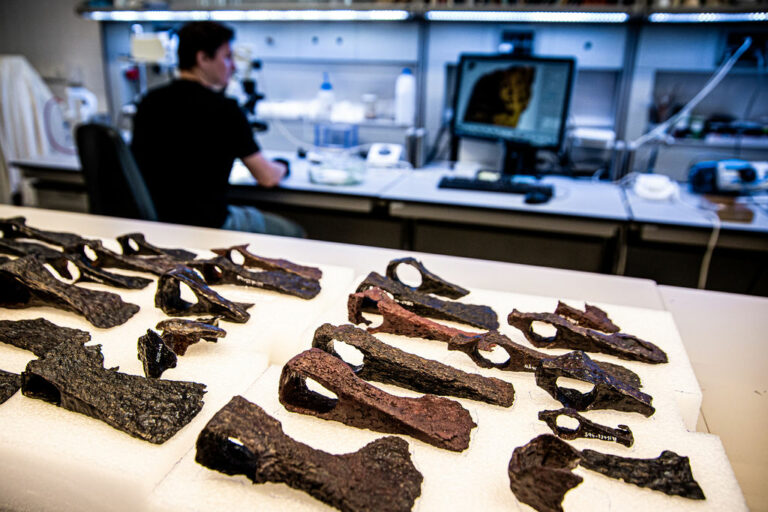
We treat, conserve and document archaeological finds before being professionally assessed and deposited in study depositories
The restoration-conservation laboratory of the Mikulčice research base. Photo: M. Bárta
Facts
Establishment of the centre
1995
Head of the research centre:
Mgr. Marek Hladík, Ph.D.
Head of the base:
Mgr. Marian Mazuch, Ph.D.
Researchers and specialists:
PhDr. Jiří Doležel, Mgr. Jana Gryc, Mgr. Marek Hladík, Ph.D., Mgr. Michal Hlavica, Ph.D., doc. PhDr. Pavel Kouřil, CSc., Mgr. Šárka Krupičková, Mgr. Michaela Látková, Ph.D., Mgr. Marian Mazuch, Ph.D., PhDr. Rudolf Procházka, CSc., Mgr. Petr Rataj, Mgr. Šimon Ungerman, Ph.D., Mgr. Petr Žákovský, Ph.D.
Mission
The research team at the ARÚB Centre for Slavonic and Medieval Archaeology focuses on topics posed by key questions on the historical development in the region north of the Middle Danube between the 6th and 15th centuries. The research is based on the assessment of the extensive and unique archaeological assemblages acquired by fieldwork at the most important early and high medieval sites of Moravia and Czech Silesia. Our team conducts excavations focused on the revision and extension of earlier excavations and also addresses the latest questions posed by current research. Besides the traditional excavation methods, we also use numerous modern interdisciplinary research tools, particularly non-destructive surveys, bioarchaeological and geoarchaeological research, theoretical modelling and archaeological experiments. Exact archaeometric procedures, which are increasingly involved in the study of material culture, form a standard part of the modern restoration-conservation activity at the institute.
Thematically, the team concentrates on the archaeological issues of 9th to 11th-century Central European polities, and especially their socio-economic and cultural relations. The centre’s defining topic is Great Moravia and its complex interdisciplinary research. The model sites that are subject to long-term examination by the centre are the strongholds of Mikulčice-Valy and Chotěbuz-Podobora. The team also studies the issues of the continuity/discontinuity of occupation in the interim period of the 10th century and the further development of Moravia and Czech Silesia within the Přemyslid state in the 11th and 12th centuries. It also studies selected social and economic phenomena of the high medieval transformation such as urbanisation, precious metal mining, etc. It performs systematic documentation and complex analyses of selected categories of the material culture of the Early and High Middle Ages.
Revealing the structure and dynamics of 9th-century Great Moravian society
Examination of Grave 2041, the seventeenth grave with a sword discovered in Mikulčice. Photo: L. Poláček
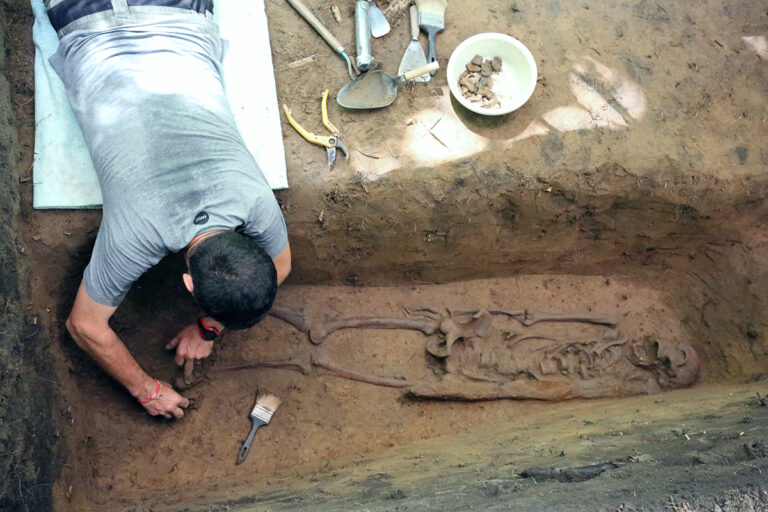
Main research subjects:
-
1. Central agglomerations and socio-economic interactions between the centre, hinterland and periphery
The main research subject is the social and economic relations of the communities living in the central agglomerations of 9th-century Mojmirid Moravia and their immediate vicinity. This research methodology is based on the principles of relational archaeology and the concept of the archaeology of revised modernity. It enables the study of more global themes using complex analysis of data from the lowest local level; in our case, Mikulčice and its hinterland.
The archaeological study of the Great Moravian centre of Mikulčice-Valy includes non-destructive surveys as well as standard archaeological excavations while engaging the interdisciplinary approach, especially bioarchaeology and geoarchaeology. Current fieldwork focuses on the verification of questions stemming from contemporary theoretical research. The emphasis is on a post-excavation analysis of the acquired archaeological material. This includes critical processing of the enormous assemblage gathered during the forty-year campaign of large area excavations at the stronghold in the second half of the 20th century and the results of later rescue, revision and systematic fieldwork.
Theoretical research prioritises topics supported by grants. A recent example is the project focused on Mikulčice’s elites resulting in a database of about 450 elite graves from Mikulčice. The corresponding grave units were subsequently analysed, including the skeletal remains. The primary outcome of the project is the representative publication Great Moravian Elites from Mikulčice (GME; 2020).
A complex assessment of the occupation of the extramural settlement (also called a suburbium), the area immediately surrounding the fortified core of the agglomeration that ensured the operation of the centre, was prepared with the support of a grant project focused on the immediate hinterland of the Mikulčice centre. The publication Suburbium des Burgwalls von Mikulčice (SBM-9; 2019) provided, for the first time, the complex archaeological processing of an entire naturally delimited settlement component of the Great Moravian agglomeration.
The relationship between the power centre and the surrounding agricultural countryside, or more precisely the farming hinterland of the centre, has long been closely followed and detailed. As the Mikulčice agglomeration is situated in a dynamically changing floodplain, interdisciplinary research of the development of the natural environment plays a key role in the study of the site. One of the long-term objectives of this research is the evaluation of extensive excavations of vanished river branches surrounding the fortified core of the agglomeration within Mikulčice’s river archaeology.
An important part of the study of the economic relations between Great Moravian centres and their periphery areas is the analysis of the spatial distribution of goods and commodities and the subsequent characterisation of their circulation regime in the territory of Great Moravia. This research provides more detailed information about the economic system of the time, which enables to derive the organisational structure of all of Great Moravia as a polity.
The archaeobotanical study of plant macro-remains from Mikulčice also helps to build the image of the economic and organisational relations in the core of 9th-century Moravian society. The acquired subsistence model at Great Moravian Mikulčice, published in the book The Archaeobotany of Mikulčice (SMB-11; 2017), is currently being further verified by both theoretical study and new fieldwork in the hinterland of the centre.
The examination of Great Moravia’s social-economic and political relations in its core territory in southern Moravia is accompanied by the research of two strongholds situated close to the northern boundary of the Great Moravian settlements ecumene, Přerov and Chotěbuz-Podobora. In this regard, we recommend, for example, the book Přerov, Horní náměstí č. p. 19, 20; 2020. These sites are related to the issues of the continuity of occupation in northern Moravia and Silesia between the 9th and the 11th centuries and the questions concerning political and cultural relations with neighbouring regions, particularly present-day Polish Silesia and remotely with the north and east of Europe. New fieldwork at the Opava-Kylešovice stronghold is yielding fundamental findings within this research.
-
2. Early medieval burial grounds and population: social structure, identity, mobility, health and food
The current focus of the research team reflects the growing interest in the study of the social structures of historical populations. The extensive and well-examined Great Moravian cemeteries are a rich source base for this research subject. A new opportunity within the broad interdisciplinary research is the application of advanced natural-science methods, especially genetic and isotope analyses. The study is part of the close interdisciplinary cooperation with two leading anthropological workplaces: The Department of Anthropology, National Museum, Prague, and The Department of Anthropology and Human Genetics, Faculty of Science, Charles University. The genetic profile of the population of Great Moravian Mikulčice is currently being examined, for the first time, within the framework of the ERC HistoGenes international project.
The specific topic of the Great Moravian burial rite and its social interpretation is part of the research focused on mortuary archaeology. The processing of Great Moravian cemeteries has resulted in several recent books. Of fundamental importance for the knowledge of the material culture of the Great Moravian elites is a detailed catalogue Nekropole an der dreischiffigen Basilika in Mikulčice (SBM-12; 2019) of the necropolis near Church 3 (the so-called basilica) in Mikulčice. Concerning the rural cemeteries, the processing of a necropolis with 1,500 graves from Dolní Věstonice (2022) is of great significance. The northern periphery of the Great Moravian settlement territory is represented by the complex processing of a barrow cemetery in Stěbořice (2013). The team also concentrates on the study of specific questions concerning the burial rite such as the form and treatment of grave pits, wooden structures in the graves, coffins with iron fittings, church interior graves, etc.
The topic is closely linked with broadly designed bioarchaeological research, a complex study of the health and alimentary habits of the inhabitants of the core of Great Moravia’s historical territory in the 9th century given its socioeconomic structure and the further development of the occupation in the 10th and 11th centuries. Selected biological indicators of the Mikulčice population including the results of stable isotope analyses show that it was a highly socially stratified society with major differences regarding access to quality foodstuffs. Strontium isotope analyses, valuable tools for the knowledge of the residential mobility of historical populations, prove the predominating local origin of the inhabitants of Mikulčice. A summary of the results of the bioarchaeological research of the Mikulčice population is published in the book Great Moravian Elites from Mikulčice (2020).
-
3. Tradition and innovation in arts and crafts
One of the topics concerning the Great Moravian elites intensively dealth with by the team members is early medieval arts and crafts. Finds from the extensive and numerous Great Moravian cemeteries provide excellent material for this study, while conservation-analytical laboratories create the conditions for the necessary exact and interdisciplinary approach. The research takes place in the context of the study of the social issues of early medieval burial grounds and the technological study of art and craft products, especially jewellery. The current state of knowledge is summed up in the book Great Moravian Elites from Mikulčice (2020), while monographic processing of globular earrings as a case study on the emergence of Great Moravian luxury jewellery is in preparation (2021). Partial topics processed in detail currently include the question of a Mediterranean influence on Great Moravian jewellery production and the issues concerning gombíky – spherical hollow buttons, which were a major symbol of Great Moravian nobility.
The second line of research focuses on the production technologies used in metallurgical and smithery processing of iron and the fine-metal working of precious and non-ferrous metals. The results of the classical archaeological study of artefacts and production facilities, followed by material-technological analyses of the artefacts, are verified by scientific experiments.
-
4. Power attributes and self-presentation in medieval society: fortification, weapons, symbolism
In connection with the study of the medieval elites and central areas, the team has long been focused on a deeper knowledge of fortified centres as political and military nodal points in the Early and High Middle Ages. Particular attention is focused on the fortification structures and their transformations in time and space, their function and the end of their existence in the context of war events. This is closely connected with the study of the turning periods of Central European history accompanied by frequent war conflicts, such as the 10th century, delimited on one side by the destruction of Great Moravian centres and on the other by the creation of the new power structures of the Přemyslid state in the 10th and the 11th centuries.
The team intensively addresses the issues of medieval and early modern arms, as well as the evidence of warfare in general archaeological records. The detailed study of these issues enables to address the questions of the broader cultural influences and impulses affecting the domestic milieu. A corpus of armour and weapons from the Czech Republic is being prepared for this purpose; see the complete list of 9th–16th-century swords from the Czech Republic’s territory (2019). This heuristic activity is closely followed by a material-technological analysis of the weapons. The results enable to study issues concerning innovation in the production and distribution of weapons in a broader geographic and temporal context.
-
5. Urbanisation and mining as part of the medieval transformation
The centre’s researchers focus on two important phenomena of high medieval society: the emergence of towns and precious metal mining. The process of urbanisation and the appearance of a complex of urban communities had a fundamental impact on the settlement and the social and economic structure of Central Europe as a whole. The city of Brno, including the systemic structure of medieval urban communities in its wider hinterland, serves as the ideal model site for the study of urbanisation processes. The team’s researchers participate in case studies as well as in complex outputs, which they prepare in cooperation with the Archaia archaeological organisation.
An important tool for understanding the crucial economic and social tendencies in the European Middle Ages is mining archaeology. The expansion of precious metal mining provided important sources for the universal development of society and the political expansion of the last Přemyslids. The research team participates in the implementation of several projects; the most important concentrate on the detailed documentation, evaluation and monitoring of the historic preservation of one of the best-preserved medieval mining complexes in Central Europe – Havírna near Štěpánov in the Bohemian-Moravian Highlands.
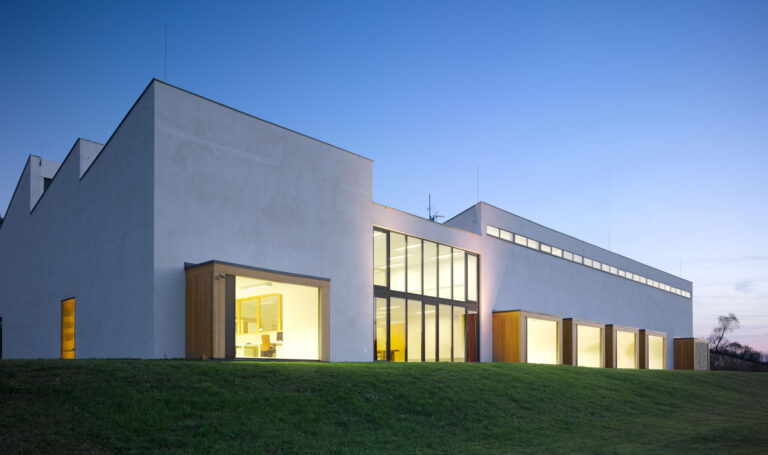
The base is not only a research centre but also a place of culture and education in the present-day archaeological landscape of Mikulčice
ARÚB research base in Mikulčice-Trapíkov. Photo: F. Šlapal
Research base
Mikulčice-Trapíkov
The Mikulčice-Trapíkov research base is situated about one kilometre from the acropolis of the Great Moravian stronghold of Mikulčice-Valy. The building began operating in 2014 as a replacement for the original base on the stronghold’s acropolis, which was damaged by a tragic fire in 2007. Occupying a strategic position near the entrance to the complex of the national cultural monument of the Slavonic Stronghold in Mikulčice, it serves as an international scientific centre and also as a place of culture and education in Mikulčice’s archaeological landscape.
The building provides everything needed for a modern archaeological workplace. The core is the researcher area with archaeologists’ offices, and conservation-restoration and analytical laboratories. Among the most important of these is the so-called wet laboratory, where the finds, botanical and other samples are washed, sorted, floated and otherwise processed and where all the voluminous objects transported “in situ” from the field can be taken apart under laboratory conditions. Extensive study depositories and lodgings for guests and seasonal workers are situated on the first floor of the base. The most impressive areas of the building include the library and the multi-purpose hall where conferences and cultural events – concerts and exhibitions – take place.
The building, the result of several years of collaboration between architects and archaeologists, was designed by architects from the Brno-based Pelčák a partner architekti office.
Read more
- Centre and research base website: https://mikulcice.arub.cz/
- National cultural monument Slavonic Stronghold in Mikulčice – Masaryk Museum: https://masaryk.info/slovanske-hradiste-mikulcice/

